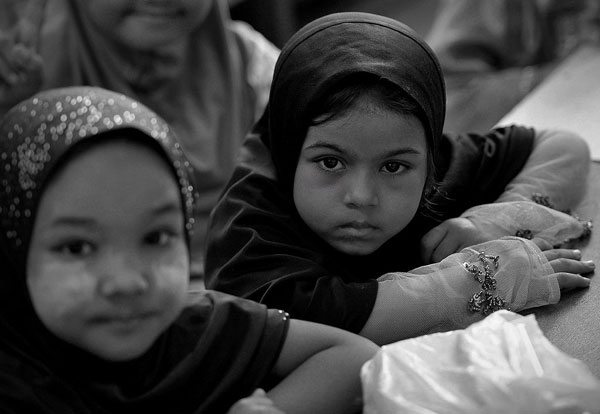
August 14, 2017; Al Jazeera
The Rohingya Muslims of Myanmar (formerly Burma) face rejection again this week as India threatens to expel them. After rejection by numerous nations, including their native one, this small ethnic group has no place to call home.
There are an estimated one million Rohingya people living scattered over southeast Asia and the Indian subcontinent, and another 1.3 million in Myanmar. An estimated 40,000 Rohingya live in India, with the greatest concentration of 7,000–8,000 in Jammu Kashmir, or J&K. Many say they wish to return home, but they cannot.
The conditions in which the Rohingya are forced to live in Myanmar have been described by the New York Times’ Nick Kristof as “modern-day concentration camps…They live behind fences and police checkpoints. They can’t leave, and doctors aren’t allowed in, even to save their lives.” As described by Human Rights Watch, Rohingya are not permitted citizenship, they are not permitted education beyond primary school, they are required to obtain travel permits to visit the next town over or to stay overnight somewhere, and they are required to perform forced labor for state-owned companies benefiting other communities.
The basis on which Myanmar denies citizenship to the Rohingya is that they are Bangladeshi refugees. While this isn’t justification for inhumane treatment or denial of citizenship, it’s also untrue. Muslims arrived in the independent kingdom of Arakan, now called Rakhine state, in the eighth century. The Middle East Institute explains that Myanmar’s political climate is heavily informed by “anti-Muslim racisms, which emerged out of the colonial-era political economy in which locals were subordinated to Indians.” The British encouraged Bengali immigration to Burma and relied on Bengali-Rohingya forces to push out Japanese invaders in 1948, while displacing Hindu Burmese villagers and barring them from military service, creating lasting resentment. Three waves of state-sanctioned violence have compelled hundreds of thousands of Rohingya to flee Myanmar: one in 1978, one in 1992, and most recently in 2012.
Rohingya in Myanmar today are forced to identify as Bangladeshi, an ethnic label they firmly reject. Bangladesh rejects them, too, and refuses to admit them as refugees. Myanmar even rejects the name Rohingya, because “it means a person of Rohang, the old Muslim term for what is now Arakan state in western Burma—as conferring historical legitimacy on the Muslim presence.”
India, too, rejects the presence of Rohingya in the politically volatile region of Kashmir. Deputy Interior Minister Kiren Rijiju told Reuters, “As far as we are concerned they are all illegal immigrants. They have no basis to live here. Anybody who is [an] illegal migrant will be deported.”
Sign up for our free newsletters
Subscribe to NPQ's newsletters to have our top stories delivered directly to your inbox.
By signing up, you agree to our privacy policy and terms of use, and to receive messages from NPQ and our partners.
The Middle East Institute translated a Facebook post recounting a phone message that a Rohingya woman left for her brother, saying, “Send us as many birth control pills as you can. They (Myanmar troops) are gang-raping our women. They are arresting and killing all our men. There is nothing else you can do. Just pray to Allah and to wish us speedy deaths! This is just simply unbearable.”
The United Nations has maintained a presence in the country for decades; their first report in 1992 noted the same conditions we see 25 years later. However, Myanmar has frequently blocked aid workers and journalists from the country, and most recently resisted UN efforts to investigate activities in Rakhine state, where most Rohingya live.
Alice Cowley and Maung Zarni at the Middle East Institute noted poignantly,
Today, while the anti-historical and institutionally amnesiac discourses such as “humanitarian concern,” “communal conflict,” “security and terrorism,” “lack of development,” and “livelihood creation” float through the ether world of foreign embassies, development, and UN agencies, the decades of facts relating to the instrumental role of the central Myanmar State in the abuses of Rohingya are buried alongside very real human corpses—again—waiting to be verified and validated by the right kind of foreign experts and the right kind of UN process…As Rohingyas in Northern Rakhine wait and their diasporic relatives post desperate calls for UN peacekeepers and intervention on Facebook, “Never again!”—the foundational myth of the United Nations—must sound bitterly hollow.
The rhetoric being thrown around in Kashmir to encourage deportation of Muslims sounds awfully familiar. They have been called “a demographic threat” to the “history, culture and identity” of Hindu Jammu, accused of being tools of Pakistani terrorist groups and of burdening local communities. Kashmir borders half a dozen states and was a major stopping point on the Silk Road; like the United States, it has always been a blend of ethnicities and cultures. However, tensions introduced by Partition riots and stand-offs with China and Pakistan have led to a volatile and divided Kashmir.
India is not a signatory to the UN agreement on refugees, and therefore does not consider its restrictions binding. However, Reuters reported, “The UNHCR’s India office said on Monday the principle of non-refoulement—or not sending back refugees to a place where they face danger—was considered part of customary international law and binding on all states whether they have signed the Refugee Convention or not.”—Erin Rubin











